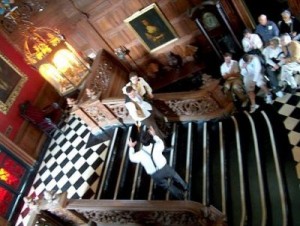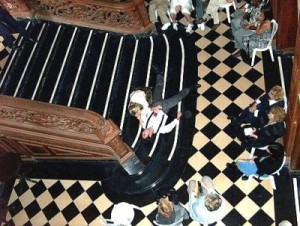
Decades before Watergate began an endless and ongoing series of political scandals bearing the suffix -gate (Irangate, Katrinagate, Monicagate, Nannygate, and the recent Troopergate, to name just a few), the biggest and most shocking scandal of its time was the 1920s’ Teapot Dome scandal. (Teapotgate? Domegate? Teapotdomegate?) The scandal began with oil tycoon Edward L. Doheny’s interest-free $100,000 loan to U.S. Secretary Of The Interior Albert B. Fall (the equivalent of over $1,000,000 in today’s currency!). Not long after that transaction, Fall leased (without competitive bidding) 32,000 acres of oil-rich government-owned land to Doheny.
Eight years later, Doheny’s son Ned and his personal secretary Hugh Plunkett were shot to death in a murder-suicide inside the mansion the elder Doheny had gifted to his son on the occasion of Ned’s wedding. Though a police investigation concluded that Plunkett was the shooter, there remains until this day doubt as to who shot the fatal bullets and what exactly motivated the crime.
In one of L.A. theater’s longest-running success stories, The Manor, playwright-actress Kathrine Bates’ fictionalized dramatization of the crime (staged in the very mansion where it took place) is now embarking on its 7th smash hit season. With audience members following a trio of “servants” to various rooms of Beverly Hills’ legendary Greystone Mansion, Bates has created an engrossing, well-performed, and entirely unique evening of theater that deserves to be seen by playgoers and history/scandal buffs alike.
Various theories for the murder-suicide have surfaced over the ensuing decades. Some have speculated that Ned and Hugh were lovers and that that Lucy killed them in a fit of jealousy. Others have hypothesized that Plunkett shot Doheny in a quarrel over his salary. A more recent theory is that Hugh had become unhinged by the possibility of facing jail time, since it was he who delivered the bribe money to Fall.
Bates solves the problem of conflicting theories by fictionalizing the Doheny family (and renaming them the MacAlisters) and creating a love triangle in which the object of Ned and Hugh’s affections (they’re called Sean and Gregory here) was not each other but the fair Abby MacAlister, who had loved Gregory but married Sean. Teapot Dome has been renamed as well (the scandal now involves a Mexican mine and Pearl Harbor) but the $100,000 bribe remains, offered to a fictional Senator Alfred Winston.
Much of the fun of attending a performance of The Manor comes from being inside its very special venue, and from the intriguing construction of Bates’ script.
My +1 and I arrived an hour ahead of time in order to spend time visiting the gorgeous grounds of 55-room Greystone Mansion and take in some spectacular views of Los Angeles. At 6:00, ticket holders were escorted into mansion’s living room and seated in three color-coded groups. Following an opening sequence involving the entire cast of characters and viewed by the entire audience, each group followed one of three servants into another room of the mansion for a series of three scenes, each in a different room. (In one of many “hats off” to Bates, the scenes have been written to be of the same length and viewable in any order.) The yellow group followed mute (but not deaf) Ellie, the maid, first visiting a bedroom where Sean and Abby attempted to consummate their marriage before an untimely interruption by Marion MacAlister, Sean’s mother. We then moved on to the card room to observe a scene involving Gregory and his brassy wife Henrietta Havesham Pugh and learned that the two Brits had married as a result of a pregnancy that turned out to be Henrietta’s way of getting her claws into hunky Greg. Finally, we visited Sean’s father Charles MacAllister’s office where the “you scratch my back and I’ll scratch yours” bribery scandal was set into motion.
Bates’ script, Beverly Olevin’s direction, and the performances of the cast of twelve have been created in the broad strokes of a TV soap (think Dynasty or Dallas set in the 1920s). What makes The Manor so special is the “you are there” fly-on-the-wall nature of the experience, and what an experience it is.
As Act Two moves ahead a decade, The Manor’s three-scenes-running-at-once construction becomes even more fascinatingly complex, with actors and audience members moving from room to room in the course of a single segment, reuniting in the foyer for the unfolding of the final tragedy.
Bates has written for herself a humdinger of a role, that of matriarch Marion, which she has portrayed at every performance since The Manor first opened. About half of the roles are double, even triple cast. April 1st’s The Manor featured performances (ranging from good to excellent) by Nina Borisoff (Ursula, the housekeeper), Jeremiah Dupre (Gregory), Katherine Henryk (Ellie, the maid), Darby Hinton (Charles MacAlister), Daniel Leslie (Senator Alfred Winston), Nicole McCloud (Abby MacAlister), Phil Persons (James, the valet), Flora Plumb (Cora Winston, the senator’s wife), David Hunt Stafford (Frank Parsons, Esq., Abby’s father), Amy Tolsky (Henrietta Pugh), and Drew Wicks (Sean MacAlister).
Stage manager Henry Lide introduced each act. Marc Olevin’s sound design features a just-right “Theme From The Manor” which sets the dreamlike, tragic mood. Greystone Mansion has been turned into the perfect setting for The Manor via set design/dressing by Stafford and Jackie Petraz.
With performances continuing to sell out, The Manor has become Theatre 40’s biggest money-maker, and justifiably so. There’s no better way to step back in time (and get and inside peek at one of the Southland’s most fabled mansions) than with a visit to The Manor.
Graystone Mansion, 905 Loma Vista Drive, Beverly Hills.
www.theatre40.org
–Steven Stanley
April 1, 2009
Photos: Bernard Samstag




 Since 2007, Steven Stanley's StageSceneLA.com has spotlighted the best in Southern California theater via reviews, interviews, and its annual StageSceneLA Scenies.
Since 2007, Steven Stanley's StageSceneLA.com has spotlighted the best in Southern California theater via reviews, interviews, and its annual StageSceneLA Scenies.







 COPYRIGHT 2024 STEVEN STANLEY :: DESIGN BY
COPYRIGHT 2024 STEVEN STANLEY :: DESIGN BY